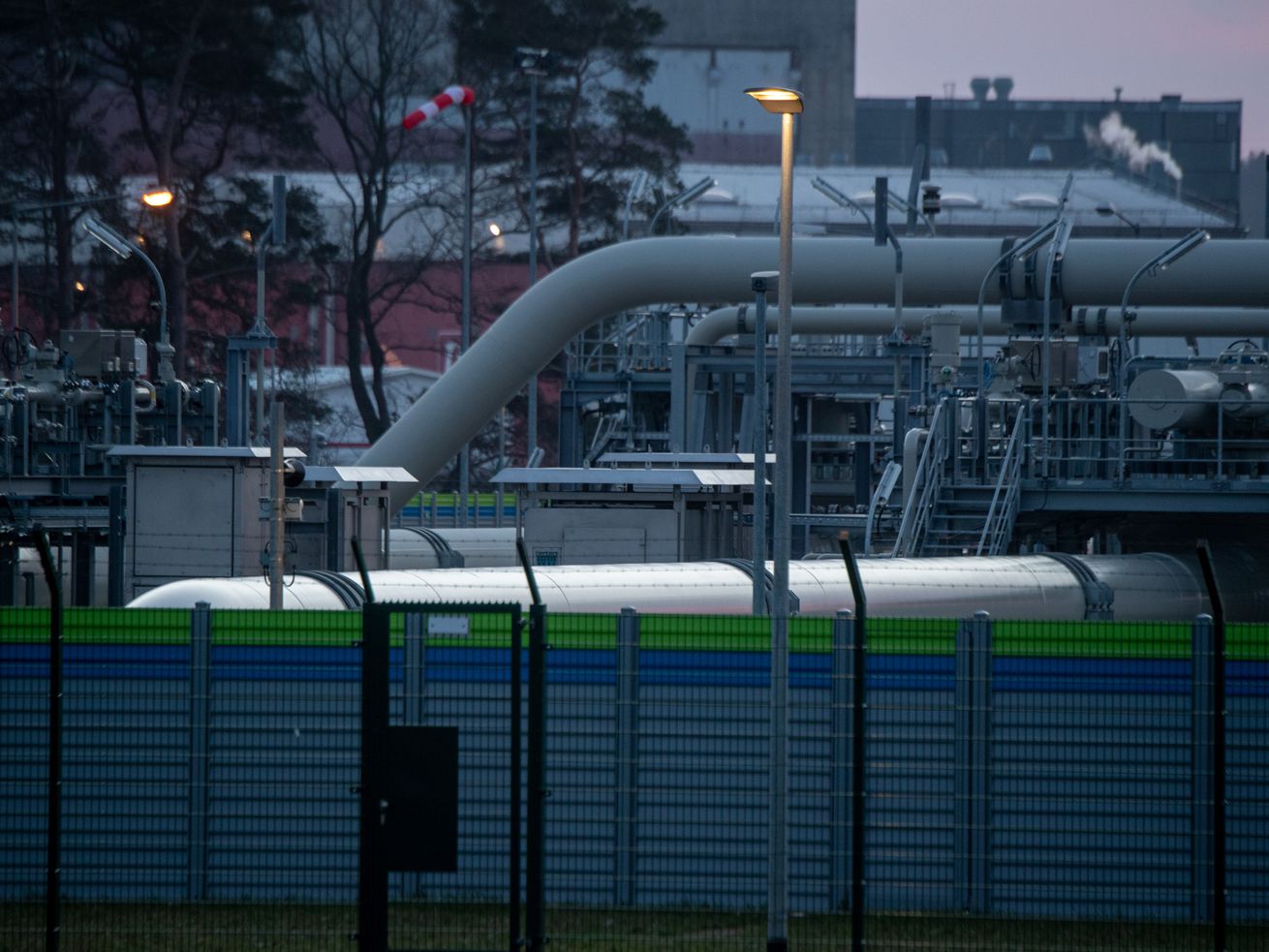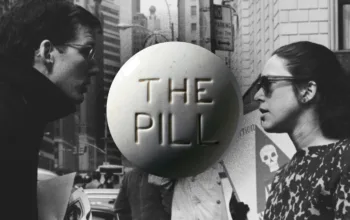Nord Stream 2 is looming over escalating Russian-Ukraine tensions.
Russia has gathered troops along the Ukrainian border, Washington and Moscow engaged in a week of high-stakes negotiations, and NATO and European allies are trying to avoid a conflict that seems more likely by the day.
In this frightening morass, there’s one low-key wild card: a long-running energy infrastructure project that some consider an economic project, others consider a geopolitical tool of Russia, and that is a combination of all of those and more.
The project in question is Nord Stream 2, an $11 billion Russian-owned pipeline that has Washington in a difficult position with some of its European allies, divided other European countries among themselves, and weakened Ukraine.
When it’s up and running, Nord Stream 2 will bring natural gas from Russia to Europe. It is laid alongside Nord Stream 1, which flows from Russia along the Baltic Sea and directly into Germany. Experts said the pipeline will not dramatically increase Russian natural gas imports to Europe, but it could reroute it — meaning more natural gas will flow directly to Germany and potentially bypass other existing pipelines that run through other European countries. Most significantly, Ukraine.
The United States sees the pipeline as a Russian geopolitical tool to undermine Europe’s energy and national security. Ukraine definitely sees it this way too and wants the pipeline stopped. Once Nord Stream 2 is online, Russia will no longer need to pay transit fees to send gas through Ukraine, and both Russia and Europe have less need to rely on the pipeline that runs through Ukraine. “The thinking is that as long as that remains a critical transit corridor for Russian supplies to get to market, Russia maybe is less likely to interfere or to disrupt that source of transit,” said Emily Holland, assistant professor in the Russia Maritime Studies Institute at the US Naval War College.
Germany has framed Nord Stream 2 as a “commercial project” essential to German industry and wants to see it operational. Some of Europe agrees; some of Europe doesn’t, or doesn’t really want to say too much either way. Add in corporate and financial interests, energy demand, and costs, and things get even messier.
And Russia, in case you haven’t figured out, wants all of those things — a geopolitical tool to get leverage over Europe, a vulnerable Ukraine, and a payout from the pipeline.
All of this has taken on an additional urgency as Russia builds up troops along the Ukrainian border, and the very real threat of war intensifies. And because of that, Nord Stream 2 is increasingly seen as leverage in negotiations with Russia over Ukraine, though there are divisions on exactly how to use it as such. (That question of just how to use it played out in the Senate Thursday over a failed effort by Sen. Ted Cruz to impose sanctions on the pipeline now.)
All these fractures — between transatlantic allies, European nations, and US and European populaces themselves — mean Nord Stream 2 has already achieved at least one of Putin’s political goals: sowing discord.
“It already has paid back for Moscow,” said Stefan Meister, head of the program on international order and democracy at the German Council on Foreign Relations. “Even if it’s not online, it already worked quite well because it has divided US-Europe-German relations. The Europeans, it has divided. The Germans [themselves], it has divided. So what else [does] Moscow need? It’s already a big success story.”
The controversial birth (and sort-of life) of the Nord Stream 2 pipeline
Before there was Nord Stream 2, there was Nord Stream 1. Before there was Nord Stream 1, there were pipelines that brought Soviet, later Russian, gas to Europe. Among these pipelines is one that runs through Ukraine that, at its peak, transited as much as 80 percent of Europe’s Russian gas imports. But in 2005, Germany and Russia inked a deal for Nord Stream 1, a roughly $6 billion pipeline through the Baltic Sea that would make Europe less reliant on this particular land route through a volatile region.
In 2015, a few years after the original pipeline opened, Germany signed a deal for a Nord Stream 2 to expand capacity along this route. But it drew fierce criticism: It was owned fully by Gazprom, Russia’s state-run gas company. The proposed second pipeline would further undermine the need for Russia to pay transit fees to move gas through the Ukrainian pipeline. And, well, timing: The agreement came after Russia had annexed Crimea and invaded eastern Ukraine in 2014.
Then-Chancellor Angela Merkel defended Nord Stream 2 as a “commercial project,” essential for Germany’s all-important industrial sector. As experts said at the time and still say today, sure, it’s a commercial project, but anything involving a Russian state-owned gas company is going to inherently be political.
Germany also looks at Russia through a slightly different lens and has a strong legacy of engagement with Russia, said Meister of the German Council of Foreign Relations. Berlin has traditionally tried to balance its commitments to Western allies with this desire to have productive relations with Moscow, and it often sees business and economic interests as a good venue for cooperation. Germany has relied on Russian gas for decades, and so Germany sees this project as a reliable and practical bet.
The idea that this is a “commercial project” isn’t meaningless. Some European companies and other interests have a lot to gain from the pipeline — or lose, if the project is killed, especially at this late stage. One reason the pipeline proceeded despite objections was “the power of those economic groups that are benefiting from this, and I think that power is gigantic,” said Margarita Balmaceda, professor of diplomacy and international relations at Seton Hall University and author of Russian Energy Chains: The Remaking of Technopolitics from Siberia to Ukraine to the European Union.
All of that helped Nord Stream 2 get built, despite objections from the United States and other allies who said it would make Germany and Europe even more reliant on Russian natural gas and so more vulnerable to the Kremlin.
The rest of Europe was similarly divided with very legitimate concerns about this pipeline being a source of Russian leverage running up alongside the reality that some countries would financially benefit from Nord Stream 2, and others see opportunity in weaning Germany and other western European countries off their Russian energy needs. “The problem with European energy security is there is no European energy security,” Holland said. “Every state has its own energy security needs and interests, and they’re completely distinct from their neighbors.”
And then there is Ukraine, caught in the middle — and whose fate is potentially intertwined with that of Nord Stream 2.
How Nord Stream 2 became a flashpoint in Ukraine’s future
In May 2021, the Biden administration waived Congressional sanctions on the company behind Nord Stream 2. The bipartisan legislation passed in 2019, a move that angered Germany and piled on to strained relations in the Trump years. (Trump’s own takes on Nord Stream 2 didn’t help.) This was part of the administration’s larger overture toward Germany to help repair the damage of the Trump years. But Biden got pushback from Congress, including from Senate Democrats, who saw Biden as acknowledging the US wasn’t or couldn’t stop the pipeline from moving forward.
Ukraine also deeply opposed this decision, given it has the most to lose from Nord Stream 2 coming online. Again, Europe isn’t getting more gas from Russia through Nord Stream 2, but it offers another option to move that natural gas. And that means Russia and Europe need Ukraine’s pipeline a lot less.
Ukraine sees this as a major threat. Russia pays Ukraine approximately $2 billion in transit fees to send gas through its territory.
But really, the big thing is that Ukraine sees the pipeline infrastructure as its own insurance policy, both with Russia and Europe. Russia wants to sell its gas to Europe; Europe needs to buy Russian gas. As long as Ukraine is in this mix, it may, at the very least, give Russia pause before sending tens of thousands of troops onto Ukrainian soil — and keep Europe a little more invested in its security.
“Taking Ukraine out of the transit equation further marginalizes Ukraine from an already pretty marginal role in the European consciousness,” Balmaceda said.
None of this is really a secret, and, to be clear, this is exactly the scenario Russia wants. “That’s why I can view Nord Stream 2 as more of a geopolitical project because it is designed to give the Russians the option to move as much gas as they can around Ukraine,” said Steven Pifer, nonresident senior fellow in the Arms Control and Non-Proliferation Initiative at the Brookings Institution.
The United States and Germany recognize this. Angela Merkel previously said that gas must keep flowing through Ukraine after Nord Stream 2, and the current Chancellor Olaf Scholz reiterated that position in December. In a July agreement between, US and Germany say they “are united in their belief that it is in Ukraine’s and Europe’s interest for gas transit via Ukraine to continue beyond 2024.” That agreement also promises Germany will try to seek sanctions if Russia uses “energy as a weapon.” But experts said the agreement is pretty vague on what that entails. Especially since Russia is arguably using energy as a weapon right now, by not increasing exports to meet the current European demand for natural gas in what some analysts see as an attempt to pressure Germany to restart the approval process for Nord Stream 2.
Germany and its partners do have some sway over Russia because Russia wants Nord Stream 2. But this leverage only lasts for as long as Nord Stream 2 stays offline. “If the Transatlantic community waits until Nord Stream 2 is operational, then a significant deterrent effect would be lost, since at that point the Kremlin will have one less dependency in Ukraine to keep in mind,” said Benjamin Schmitt, a postdoctoral research fellow at Harvard University and senior fellow at the Center for European Policy Analysis.
Nord Stream 2 is tearing just about everyone apart — including inside the US
This is why Nord Stream 2 is tied to efforts to avert a Russian military invasion of Ukraine. In the lead-up to talks this week, Russia made security demands of the United States and NATO, many of which are nonstarters for allies. The US has threatened harsh sanctions and other punitive measures, but Biden administration officials also say they see Nord Stream 2’s limbo as a bargaining chip.
Not everyone sees it this way, though. Some US politicians and experts think the best way to stop the pipeline and deter Russia is by sanctioning Nord Stream 2 now. This is why Sen. Cruz and other Republicans pushed to reinstate sanctions on Nord Stream, a bill that put Senate Democrats — especially those who’ve previously backed these penalties or are in tough reelection battles this year — in an uncomfortable position. (It also didn’t help that Cruz got this vote by holding up Biden’s national security nominations for months.)
But the Biden administration sees it differently and advocated against the legislation, saying imposing sanctions right now would mean they lose any deterrent effect. Or as Pifer put it: It may be the equivalent of “shooting the hostage.”
Senate Democrats largely rallied around the administration’s position, and as a consolation, have proposed their own legislation to impose sanctions if Russia advances military into Ukraine. This includes steps for more penalties on Nord Stream 2, and for now, that was enough to convince some Democrats to reject Cruz’s bill. Russia has.
But the division within the United States reflects the even larger fractures over Nord Stream 2, made worse by the Ukraine crisis. Deputy Secretary of State Wendy Sherman, when asked about Nord Stream 2 this week in Brussels, reiterated a line her boss Antony Blinken said earlier this month: “From our perspective, it’s very hard to see gas flowing through [the] pipeline for it to become operational if Russia renews its aggression on Ukraine.”
But the question really is where Germany stands. Scholz has indicated serious reprisals are on the table if Russia invades Ukraine, but he has also maintained that Nord Stream 2 is a “private sector” project. Even within the German government, rifts exist. The leadership of the Greens, Scholz’s coalition partner, have long opposed Nord Stream 2. “This government, they have to find their approach on Russia, on energy, on Nord Stream 2, and so they are still in a period where they have to find their positions,” Meister said.
Russia’s troop buildup against Ukraine is putting pressure on Germany to find its position fast, along with the rest of Europe. Right now, any escalation of the conflict in Ukraine could further threaten European gas supplies, making for a potentially difficult winter in Europe. Still, some experts told me this idea of Russia turning completely turning off the spigot of natural gas to Europe is a bit overblown, and that is largely the view in Germany. Europe has been relying on this gas infrastructure for decades, through lots of turmoil, and it also goes against Russian interests to a degree — Gazprom means a lot to Putin and his oligarch friends.
That doesn’t mean Russia can’t exploit the situation, manipulate in more subtle ways, or use energy as a pressure point, as it’s doing now. Nord Stream 2 gives Russia another avenue to do so. This will prove critics right who say Germany and others are too reliant on Russian natural gas imports. But it’s also hard to ignore the reality that Russian gas is just a lot cheaper than some other current alternatives for Western Europe. Those trade-offs are not unique to Europe.
Nord Stream 2’s current not-quite-completed status will be seen as both a deterrent to war in Ukraine and a punishment option in the event there is one. If Russia invades Ukraine, it is very likely Nord Stream 2 will be dead; the pressure from the European Union, the US, and other allies will be difficult to overcome. “If the Russians do that, and the Germans don’t kill Nord Stream 2,” Pifer said, “then I expect that the Biden administration would say, ‘Fine, we’re not waiving any sanctions. Mr. Cruz, pass your legislation.”
Correction 1/14, 7:00pm: A previous version of this story referred to Gazprom as a Russian state-owned oil company. It is a state-owned gas company.
Author: Jen Kirby
Read More



